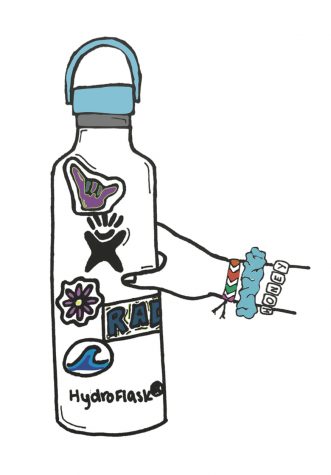Social media’s influence on teens: for better or for worse?
September 15, 2019
In our modern, technological world, the growth in the population of cellphone users is often displayed through the increase in the use of social media applications and popular content. Smaller and smaller hands now grasp at the progressively larger devices, creating an extremely phone-dependent generation. According to a survey conducted by Sell Cell, 40 percent of kids in the United States were six or under when they first used a cellphone. Social media trains young minds to think and behave in different ways.
Today’s technology centers around and specifically targets the teenage population. They represent a significant portion of dependable smartphone customers, as they are constantly buying newer phones to fuel their screen addiction and keep up with the fast pace of technology companies. According to a Pew Research Center report in 2018, 54 percent of teens in the United States admit that they spend too much time on their cellphones, and 41 percent say they spend that time on social media. The devotion shown by teenagers toward their technology has started to increase the number of mental issues such as low self esteem, depression and anxiety that are manifesting themselves earlier and earlier, according to Pew Research Center.
Simone Rodin, PhD and director of Wellspring Psychotherapy Center in San Rafael, mentors teens through social issues, many of which originate from cell phones.
“There has been some research showing that the longer people spend on social media, the less empathy they have for others in real life situations,” Rodin said. “I think that too much time spent in [an online] world can dull people in the real world and to real interactions.”
Nowadays, children have the ability to hide behind screens and send anonymous messages, which can promote harassment and cyberbullying. Snapchat trends such as posting Saraha and YOLO links allow for anonymous messages to be sent to the user who posts the link to their story.
According to another study by Pew Research Center, 15 percent of teens think social media alters reality and gives teens an unrealistic view of other people’s lives. Due to this distortion of reality, misunderstandings are more likely to occur, and with an anonymous user profile to hide behind, individuals speak without thinking about the consequences of their words, according to Pew Research Center.
The opposite situation is represented by apps such as TikTok and VSCO, where your actual face is often the main part of your post. Popular social media platforms such as Instagram, Facebook and Snapchat now compete against apps that mainly attract younger users, namely VSCO and TikTok. VSCO is an app used to edit and post photos, but has now started an entirely new idea of the “VSCO girl.” TikTok has also been affected by this trend, as short videos on the app focused on the archetype have become more prevalent. All of this has contributed to further spreading of the VSCO girl trend.
What is posted on the web is often seen by far more people than is known to the original creator. For example, TikTok has a “For You” page where content is recommended to individual users without notifying the owner.
With the enormous amount of people on social media, content can be spread nationally with the tap of a button. According to Pew Research Center, 95 percent of teens in the United States have access to a smartphone. With almost the entire American teenage population on these devices, posts, news and gossip can spread like wildfire.
The VSCO Girl trend took over the internet during the summer of 2019 and is an example of how rapidly online crazes can spread as determined teens seek new ways to fit in.
“[The] VSCO-girl lifestyle is less about the app itself than accouterments like Crocs; handmade Pura Vida bracelets; the aforementioned Hydro Flasks… Often the companies are tagged in Instagram posts, blurring the line between appreciation and endorsement,” according to The New York Times.
Though some believe that the entirety of the class of 2023 embodies the VSCO Girl stereotype, not all freshmen associate themselves with the trend. Freshman Gillian Reynolds considers the new trend to be inaccurate and irritable.
“I personally think it’s a little bit obnoxious, because we’ve turned an app into a personality trait,” Reynolds said. “If I were to consider VSCO a personality trait, I would say [it requires] having very basic and trendy things like scrunchies, big t-shirts, a puka-shell necklace and your hair in a messy bun. There are certain phrases and stuff that a VSCO Girl will supposedly use.” 
The VSCO Girl trend sets a very materialistic standard on style because the look is based primarily on what you wear and use, according to the New York Times. Products associated with the style have been popularized through apps like TikTok, VSCO and Pinterest. Teens are obsessing over material goods and are targeted by companies such as Mario Badescu, Pura Vida and Hydro Flask, all brands directly involved with the trend. In order to follow the trend, there is an unspoken requirement to own these items, pressuring teens to change their lifestyles everytime a new style goes viral. These companies resort to incessantly pestering teens with deals for unnecessary products due to the influence of social media. Rodin has seen examples of this materialistic tactic which has been used in many previous fads.
“I think also there’s this idea with social media of the ideal… For girls and boys it is looking at [social media] pictures and feeling like, ‘Oh, this is how I need to look,’ or ‘This is who I need as my friend,’ or ‘This is the music I need to listen to in order to fit in,’” Rodin said.
VSCO, TikTok and other social media sites are often places for VSCO Girls to be the punchline of many videos, and they are constantly targeted by numerous apps. As part of the class of 2023, Reynolds sees the bullying targeted at her grade on a daily basis.
“There’s a big thing on Tik Tok with freshmen being VSCO girls and it’s just making fun of them. I think it’s honestly harmless and funny to watch people make fun of my own grade. It doesn’t really bother me at all,” Reynolds said.
Additionally, the new wave of YouTubers is becoming one of the main sources of teen entertainment, according to Pew Research Center. Emily Novia, a junior at Tamiscal High School, has now become a successful YouTuber with more than 20 thousand subscribers, but she believes there are consequences to social media trends.
“For the most part, I think social media can be very toxic in a way, especially with… clothing trends,” Novia said. “Everyone always feels like they have to fit in, and I definitely think it can affect kids in a negative way.”
YouTube has also gained notoriety in the past 10 years. YouTubers post content regarding trends and other reactions that have to do with their individual lives. Novia has experienced how trends play a significant role in the YouTube community and how becoming a YouTuber has affected her time on social media.
“It affects my life mostly by how much time I spend online editing videos and trying to get videos up,” Novia said. “I also spend a lot of time online looking at what other people are doing to try to make sure my videos [are] on trend and I can put out some content that people will actually want to see.”
With increasing amount of time spent on screens for entertainment, social media and keeping up with trends the lives of the average teenager have become embedded with cell phones. According to Pew Research Center, 56 percent of teens associate the absence of their phone with loneliness, being upset or feeling anxious, proving phone addiction is not beneficial for teenagers. Greater Good Magazine, a scientifically-backed lifestyle magazine based in UC Berkeley, often reports the effects of phone usage on our lives.
“The spike in the amount of time teenagers spend on screens is a likely cause of the ongoing surge in depression, anxiety, and suicide that began shortly after smartphones and tablets became widespread among teenagers,” stated the magazine.
Although sometimes harmful, social media can bring people together and provide entertainment for an online generation.
“Social media is a way that teens can connect very quickly with other teens and for some people who have a harder time finding like-minded people to connect with in person, they can get online. It’s a faster way for teens to communicate with each other,” Rodin said.
Novia has a personal take on the benefits of stepping outside of one’s comfort zones when it comes to social media as well.
“When I started gaining followers on YouTube, I had some people reach out to me want[ing] to film, which is actually pretty cool that people see what I’m doing and they actually like it and take an interest in it,” Novia said.
As this generation continues to gravitate toward technology, there are certain improvements we can make to help avoid problems such as anxiety, depression and sleep deprivation, according to Pew Research Center.
Although Pew Research reports that 95% of teens have access to a smartphone, new software developments allow screen time to be limited and tracked, aiming towards healthier lifestyles.






